Excerpts from Jim Conrad's
Naturalist Newsletter
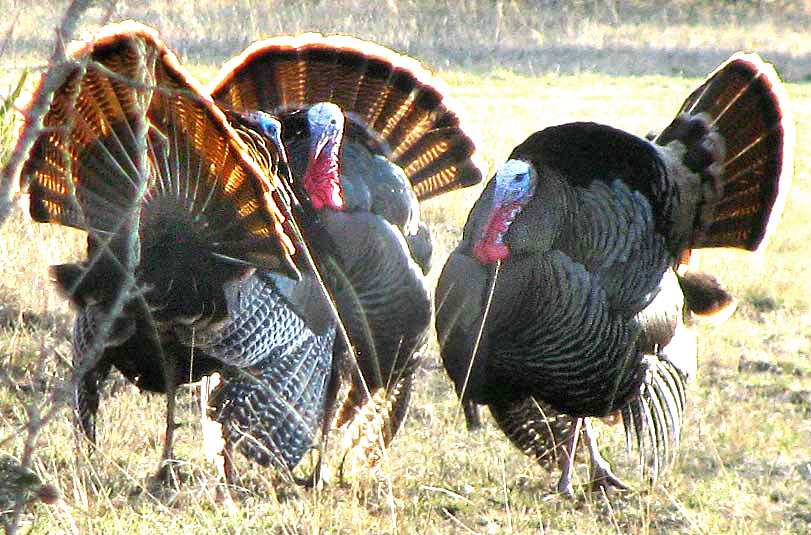
from the the March 3, 2013 Newsletter issued from the valley of the Dry Frio River in northern Uvalde County, southwestern Texas, on the southern border of the Edwards Plateau; elevation ~1750m (~5750 ft); N29.62°, W99.86°; USA
STRUTTING TURKEYS
Spring is in the air, a whole new season of baby-making is on hand for many creatures, and often on mornings when I jog in the predawn darkness it's with the accompaniment of Wild Turkeys calling from their tree roosts along the little Dry Frio River. They're not gobbling but rather making different sounds, sounds conveying a sense of excitement there among the trees, and you wonder just what is going on and what's on their minds.
Later in the morning after the sun comes up flocks of thirty to fifty or more turkeys can be found foraging along roads, in fields and even people's front yards. In this community they're not as wild as out in the ranchlands, but they still don't like for people to come too close, so when they see you coming they run away on their long legs, somehow ganglingly reminiscent of little feathered dinosaurs, which the fossil evidence and genetic sequencing tells us that all birds more or less are.
Typically in a flock of fifty or so they'll all be keeping in a loose flock, each bird busily foraging in the grass for seeds, grasshoppers, whatever, but at the edge of the flock and a little apart there will be two or three tom turkeys keeping close together, often fanning out their tail feathers, holding their wings out and fluffing their feathers, making themselves look larger, and the featherless skin on their heads and necks is very bright blue and red, all shown in the above picture.
The rest of the flock consists of rather slender, skittery females and "poults," a poult being an immature turkey, pheasant or similar kind of bird. Nowadays the few "toms," or males, strutting so splendiferously at the flock's edge are transformed by increasing daylight hours, which stimulate their sex hormones. As days become still longer and warmer, the hen population will fragment into small flocks and disperse widely to good nesting spots. Soon the strutting fraternity of toms will split up, too, each bird following hens around in the woods, gobbling lustily, trying to attract as many to his harem as possible.
On each puffed-out chest of these lumbering, strutting toms there's a conspicuous "beard," as you can see below:
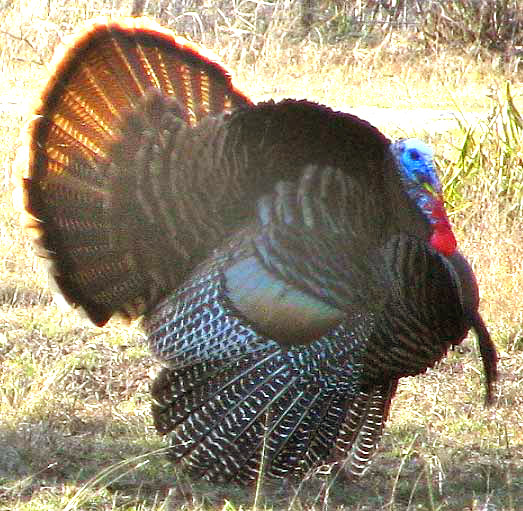
The beard's stiff, featherlike hairs are called "bristles" or "mesofiloplumes." The beard grows slowly, year after year, and can reach a foot long. Therefore, the longer a tom's beard, the older he is, and from the typical hen's perspective that's a desirable trait. Females prefer toms with long beards. It makes sense, evolutionarily, because a tom with a long beard is clearly one smart enough and powerful enough to survive to a long-bearded age, and therefore is more worthy to pass his genes along to the next generation.
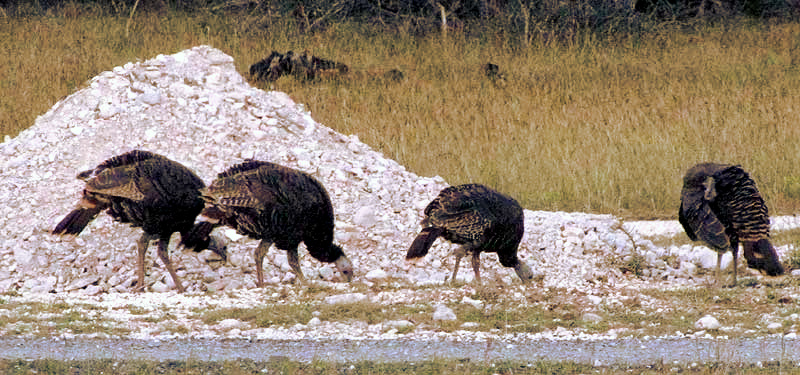
from the the November 4, 2012 Newsletter issued from the valley of the Dry Frio River in northern Uvalde County, southwestern Texas, on the southern border of the Edwards Plateau; elevation ~1750m (~5750 ft); N29.62°, W99.86°; USA
TURKEYS EATING GRIT
Someone has dumped a pile of limestone gravel at the edge of a field not far from the Dry Frio River, and at dusk Wild Turkeys go there and peck, as you can see in dusk's dim light above.
It makes sense that turkeys would gather there pecking, for they need sand or small gravel for their gizzards, which helps them digest their food. The mineral particles serve as "teeth" in the gizzard. It works like this:
The turkey swallows food and stores it in its crop if the food isn't needed immediately. Then the food passes into the "true stomach," or proventriculus, which secretes juices that help break down the food chemically. Then the food passes into the gizzard, also known as the ventriculus, where the gizzard's powerful and tough muscles grind the food with previously-swallowed stones. The food's next stop is the intestines, and then out.
All birds have gizzards, but not all birds swallow stones for gizzard grit.
from the October 21, 2012 Newsletter issued from the valley of the Dry Frio River in northern Uvalde County, southwestern Texas, on the southern border of the Edwards Plateau; elevation ~1750m (~5750 ft); N29.62°, W99.86°; USA
TURKEY ROOST
Each evening just as the day loses its last light, in a certain spot along the wooded banks of the little Dry Frio River near the cabin the turkeys go to roost. It's a pretty thing to watch, seeing the big birds a bit clumsily but ever so vigilantly ascend the trees limb by limb, constantly craning their necks first in this direction, then that. They display a primitive alertness and excitement such as our human ancestors must have felt with the approach of a night of darkness. Below you can get a hint of what I'm talking about as part of a flock climbs into a big, riverside Pecan tree:
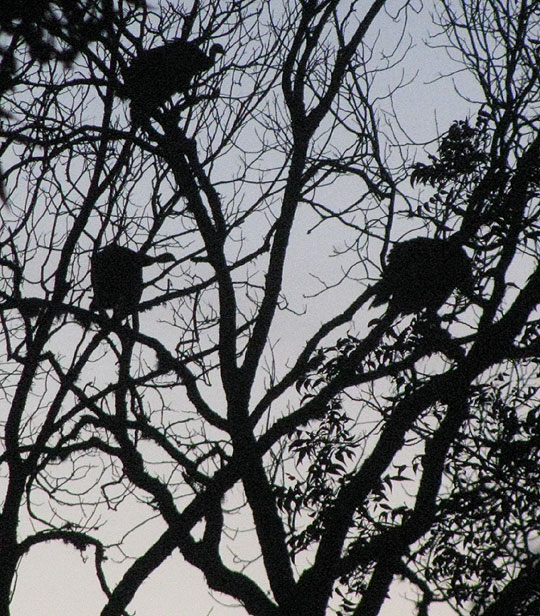
I read that in this area Wild Turkeys establish different summer and winter roosts. The winter roosts, typically located along streams and rivers or in large valleys, host large numbers of birds. But then as spring nesting season approaches the birds spread into the landscape and establish smaller, more private roosts.
Of course ground-loving turkeys roost in trees because they're safer from their predators there, and can see their predators better from above. If they need to fly, they're already in the air with a head start.
Property owners wanting Wild Turkeys to feel at home on their land should provide appropriate large trees for the turkeys to roost in. The roost is profoundly important to a turkey.
from the August 22, 2004, 2004 Newsletter, issued from near Natchez, Mississippi, USA:
THREE TOM TURKEYS AT WANDER TIME
Late Wednesday afternoon I'd gone into my trailer to check something in a book when I looked out my back window and saw three tom turkeys sauntering down the grassy road to the entrance, not ten feet away. Surely the turkeys' minds registered the strangeness of the barn with its open door, and my trailer with Beethoven playing on the radio, and the danger of being in an open area so close to the highway, but there they were.
I hadn't realized what large, otherworldly birds Wild Turkeys really are. Surely when they stood erect their heads were three feet high! Being hot, they walked with their beaks open and held their dark feathers so close to their bodies that the feathers looked like scales. In fact, the first thought I had seeing them was that it was true what a paleontologist recently said -- that the dinosaurs never went extinct. It was just that the scales of some dinosaur species elaborated into feathers, and those dinosaurs evolved into birds.
From the breasts of two of the birds arose slender, black, horsetail-like "beards" so long that they nearly touched the ground when the birds walked bent low, searching for grass seeds. The third had the beginning of a beard, about two inches long, which weirdly stuck straight out from its chest like a stiff, black finger. I read that "On the approach of the first winter the young males show a rudiment of the beard or fascicle of hairs on the breast, consisting of a mere tubercle, and attempt to strut and gobble; the second year the hairy tuft is about three inches long; in the third the turkey attains its full stature, although it certainly increases in size and beauty for several years longer."
This suggests that I was seeing three male toms, two in their third year and another in its second. However, it isn't clear from what part of the country the author wrote the above, and maybe our birds grow beards on a different schedule. Another source says that females rarely grow beards, so maybe the short-bearded one was a female?
Lots of information about Wild Turkey behavior is at http://birdsbybent.com/ch61-70/wturkey.html.
from the February 29, 2004 Newsletter, issued from near Natchez, Mississippi, USA:
DAWN GOBBLING & STRUTTING
For the last couple of weeks on several mornings at dawn I've been hearing a turkey gobble not far away. This makes sense because at this time of year tom turkeys go strutting and gobbling, advertising for hens. Studies show that this breeding behavior is triggered by increasing day length. Apparently our recent colder-and-rainier-than-usual weather hasn't fazed this particular tom, though that can be the case.
The gobbles seem to originate from two grassy clearings in the woods established for deer browsing. Hunters refer to such strutting locations as strut zones, and a tom might strut on as many as six of them. During the cold months the turkeys have kept together in flocks, but until lately I've not seen or heard a single one of them. That's something, because during the hot months just about every time I walk down to the pond I can count on seeing one or more hanging out on the grassy road between the woods and the Loblolly Field. Now that gobbling has begun, the flocks will fracture into individuals and small groups.
In Mississippi, turkey hunting season is from March 20 to May 1. It's estimated that in our state we have about 294,000 Wild Turkeys, and last year 35-40,000 were killed. That means that, if you're a wild turkey in Mississippi, each year you stand about one in eight chances of getting shot. It also means that, taking the entire state as a whole, about 0.8 turkeys occur per square mile.
from the February 3, 2013 Newsletter issued from the valley of the Dry Frio River in northern Uvalde County, southwestern Texas, on the southern border of the Edwards Plateau; elevation ~1750m (~5750 ft); N29.62°, W99.86°; USA
THINKING ABOUT WILD TURKEY SCAT
The other day I came across the scat shown below:
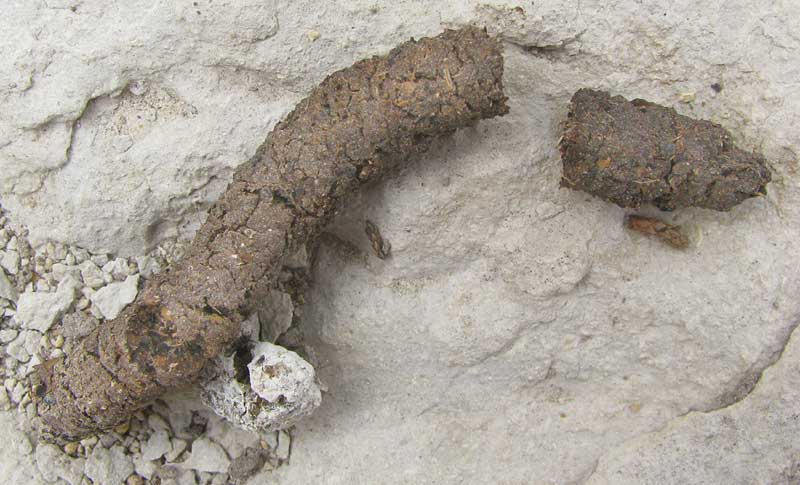
The scat was about as thick as my little finger and so dried out that it had broken. One of the pieces broken off is the white tip at the bottom, right of the longer brown piece. Here's the thinking process I went through to figure out what it was: First, the size tells us that it was no small creature like a mouse or sparrow.
The white, broken-off end is important because that whiteness is uric acid. It happens that among the higher animals there are two main ways of getting rid of the nitrogenous wastes removed by the kidneys from the bloodstream. Most amphibians and mammals, including humans, pee out water in which the nitrogenous wastes are expelled in the form of urea dissolved in the water. Most birds and reptiles have a more efficient method requiring less water. They convert their nitrogenous wastes into white, pasty uric acid, which is daubed onto poop as it exits the body, and that's why the broken-off tip of our poop is white. Therefore, we know that in the picture we have the scat of either a large reptile or a fairly large bird. In Mexico our Black Iguanas might have produced scat similar to that in the picture, but up here we don't have any reptiles capable of producing such large turds. Therefore, the question becomes, "Which large bird species made this?"
Looking closely at the poop's content we see that there are seeds and parts of seeds, maybe some insect parts, and some dirt that surely was ingested as the bird pecked for seeds and insects on the ground. That disqualifies hawks and other bird predators, for their scat would contain bones and feathers of their prey.
Other large birds in our area include herons and cranes, but their excrement normally is looser and watery. I suppose it could be Pheasant, but I've not run into that species here. At this point you just can't avoid the obvious: It's Wild Turkey scat, which it has every right to be because Wild Turkeys are abundant in this area.
To confirm the diagnosis, pages on the Internet inform us that Wild Turkey scat is cylindrical and blunt-tipped, often gently curving like ours, or J-shaped. And it's composed of the remnants of seeds and insects like ours. Of course the size can vary and the color, shape and texture can differ tremendously from that of our specimen, depending on the foods recently eaten and the health of the bird.
I have read that the male gobbler's droppings usually take the shape of a "J" or sometimes a question mark, while the hen leaves droppings more closely resembling a spiral dropped into a pile. I haven't been able to confirm that, however.
from the March 24, 2013 Newsletter issued from the valley of the Dry Frio River in northern Uvalde County, southwestern Texas, on the southern border of the Edwards Plateau; elevation ~1750m (~5750 ft); N29.62°, W99.86°; USA
TURKEY WING DRAG-MARKS
Wild Turkeys continue to strut here. One morning this week the little gravel road passing by the cabin was found to be marked with many scratchings such as those appearing below:
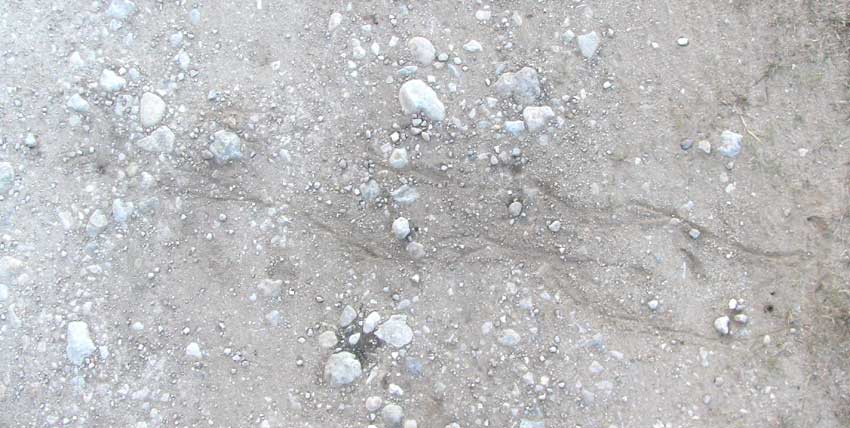
Especially on the picture's right side you can make out some toe marks left by a strutting turkey, but the main scratches are the wavy lines along both sides of the footprints. The wavy lines are called wing drag-marks because they're formed when the strutting tom droops his wings so that they scrape against the ground as he walks forward. I guess that dragging stiff wings across a gravel road's fairly hard surface makes considerable noise and maybe throws up some dust, which might impress attentive females. And of course the idea behind strutting is for the tom to display his strength, vigor and enthusiasm.
Turkey hunters know all about Wild Turkey wing drag marks and believe that when they're discovered the good hunter will return later in the hope that turkeys will be revisiting the same spot. However, until that one morning this week there'd been no such markings on our road earlier this season, and none since. But, that morning, there must have been twenty or so such scratchings.
from the October 14, 2012 Newsletter issued from the valley of the Dry Frio River in northern Uvalde County, southwestern Texas, on the southern border of the Edwards Plateau; elevation ~1750m (~5750 ft); N29.62°, W99.86°; USA
CLOSE LOOK AT A TURKEY FEATHER
On the ground around here you find plenty of what's shown below:
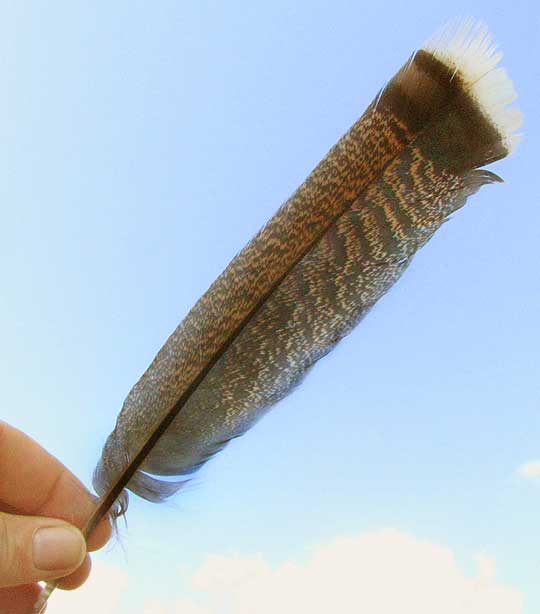
That's a feather from a Wild Turkey, which are abundant in the valley of the Dry Frio River. Most mornings when I jog at dawn flocks of more than twenty turkeys watch me from the fields as I run by. I live on Turkey Trot Road. Those feathers are everywhere.
As with everything in life, once you start studying something -- something even as simple as a feather -- you find that there's a lot to know about it.
For example, feather tips can be pointed, rounded or squared. Our turkey feather is one of the minority of squared ones. Birds grow two kinds of feathers. The "contour" or "vaned" type covers the bird's body, then beneath the contour feathers lie down feathers. The feather in the picture is a contour type. Down feathers are smaller and fluffier.
The stiff, sharp "stem" by which the feather in the picture is held is the quill, or calamus. The stiff "midrib" running up the feather's center is variously called the rachis, shaft or stem. The main, flat, often pigmented part of the feather is known as the vane. The vanes of most feathers, like ours, have one side narrower than the other. The vane's narrow side is known as the outer vane and of course the wider side is the inner vane. The lowest and usually the widest part of the inner vane is often recognized as the "up-curved edge."
Each semi-stiff little item arising from the rachis and meshing with its neighbor to form the flat vane is a barb. If you put our feather right up to your eye or use a low-power hand lens, and have a good light behind the feather, you can see what's shown below:
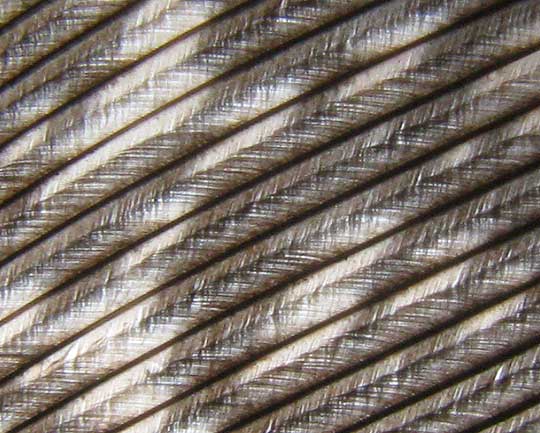
The dark lines running diagonally across the image are barbs. You can see that each barb is itself like a tiny feather, in that soft, feathery items arise from its sides. These feathery items are barbules. Notice that barbule tips on adjacent barbs overlap one another. Just by looking at how the barbules are arranged you can guess that the barbules of neighboring barbs somehow stick together, maybe in a Velcro-like manner.
It happens that a fine microscope with a camera adapter is available to me, so I've been able to take an even closer look at what's going on with these sticking-together barbs and barbules. Using the microscope's weakest magnification I looked at a barb in our turkey feather in which the barbules on one of its sides were attached to its neighbor's barbules, but the barbules on the other hung in the air because I'd pulled the barbs apart there. That image is shown below:
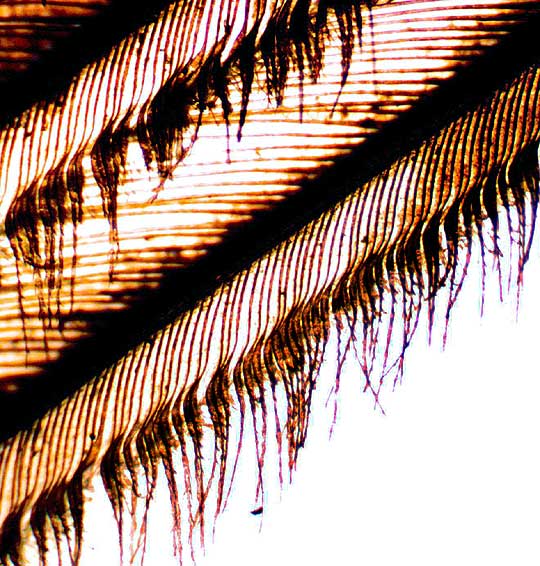
Notice that the downward-directed barbules of the silhouetted barb at the top, left partially overlap the horizontal barbules of the silhouetted barb at the bottom. Also, look at how the half of each barbule nearest the barb appears to be stiffer and more neatly organized parallel with its neighboring barbule than the barbule's outer end. Also, in the lower, right corner of the picture notice how the barbules' outer end bears tiny, spine-like items. You can see the spine-like items at a higher magnification below:
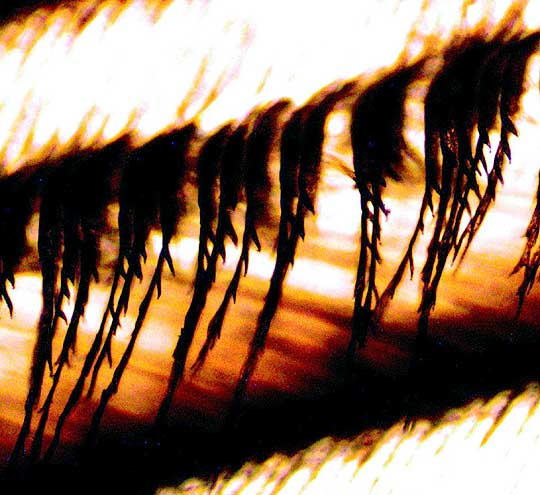
These spine-like items are "hooks," so already you can guess that barbules from neighboring barbs stick together because hooks on the barbules latch onto the barbules of its neighboring barb. In the last picture, notice that many of the hooks really are hooked.
What a world a feather is!
from the July 14, 2002 Newsletter, issued from near Natchez, Mississippi, USA:
TURKEY BROODS
Larry Butts up near Vicksburg writes about what he saw this week on a backcountry road near his home:
I saw 3 different hen turkeys with their broods. The little turkeys were in different stages of development with some being the size of quail and some being half as big as their mother. What a sight! The ability to hide is already ingrained in these young turkeys. They did not tarry very long in the road. Also the deer are beginning to bring their young out. The deer have a reddish coat at this time but will be gray in the winter.
from the April 17, 2005 Newsletter, issued from California's Sierra Nevada Foothills west of Sacramento:
WILD TURKEYS IN CALIFORNIA
Several times this week a Wild Turkey has come around my trailer. As with the Mule Deer, the moment I saw her I knew she wasn't like a Mississippi turkey: Even when I walked fairly near, she wouldn't fly away. I'm used to turkeys hiding themselves masterfully and flying away at the merest hint of anything unusual.
When I saw the turkey I recalled a map showing the species' original distribution and I was pretty sure that it had indicated that the bird was essentially an eastern North America species, but introduced in many areas outside its range. After a little Googling I found that the topic of "the Wild Turkey's original distribution" is a hot topic.
If we say that its original distribution is what it was in Columbus's time, then most experts seem to agree that originally Wild Turkeys were not present in California. However, if we go back to the Ice Ages and before, then there's good evidence that California once had them. The turkeys I'm seeing now, however, result from introductions made by the California Department of Fish & Game.
The question of whether Wild Turkeys are native or not is important. Wildlife managers use the rule of thumb that the introduction of a non-native species usually is bad because the local ecology didn't evolve to accommodate the species, while the reintroduction of an extirpated species usually is good because it adds diversity and stabilizes the local ecology by "filling in holes" in the local ecosystem's web of life.
from the October 2, 2011 Newsletter issued from Mayan Beach Garden Inn 20 kms north of Mahahual, Quintana Roo, México
WILD TURKEY DOMESTICATION
The other day Glenn outside Washington, DC wrote asking what I knew about the South Mexican Turkey, Meleagris gallopavo gallopavo, one of several Wild Turkey subspecies, and one which most authorities seem to regard as extinct in its native southern Mexico. Subspecies are usually geographically isolated populations displaying genetically based differences between them and the rest of the species, but the differences aren't so great that individuals from the two populations can't mate and produce viable, usually intermediate-looking offspring. The South Mexican subspecies appears to have been smaller than all other Wild Turkey subspecies occurring throughout North America.
Glenn directed me to the Domesticated Turkey's Wikipedia page where I read the following:
The Aztecs domesticated the southern Mexican subspecies, M. g. gallopavo, giving rise to the domestic turkey. The Spaniards brought this tamed subspecies back to Europe with them in the mid-16th century; from Spain it spread to France and later Britain as a farmyard animal, usually becoming the centerpiece of a feast for the well-to-do. By 1620 it was common enough so that Pilgrim settlers of Massachusetts could bring turkeys with them from England...
No references were provided for the above story, plus I knew that the Aztecs didn't domesticate the turkey, since most of the turkey's domestication process took place centuries before the Aztec culture formed. Therefore, I need to confirm the story from other sources. It turned out that the Mexico --> Europe -->; North America history is essentially true, plus I turned up a little extra information.
First, Wild Turkeys in southern Mexico initially were domesticated not to be eaten, but for their feathers, which were used ceremonially and for feather robes and blankets.
Also, the Anasazi of the US Southwest independently domesticated turkeys from a wild subspecies in their own area, but those birds -- both the wild and domesticated ones -- appear to have gone extinct.